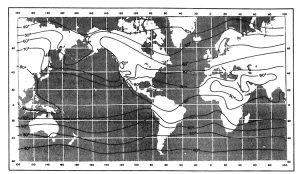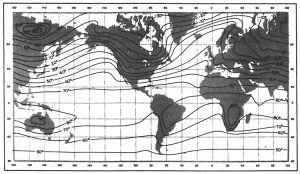[Update: In December 2022, the FAA published the Aviation Weather Handbook (FAA-H-8083-28) which replaced Advisory Circulars 00-6 and 00-45.]
This week, we’re taking another look at weather and focusing on its cause: the heating and cooling of the Earth’s surface and atmosphere. More on what every pilot needs to know about weather can be found in the FAA handbook Aviation Weather (AC 00-6A).
The amount of solar energy received by any region varies with the time of day, with the seasons, and with latitude. These differences in solar energy create temperature variations. Temperatures also vary with differences in topographical surface and with altitude. These temperature variations create forces that drive the atmosphere to its endless motions.
Diurnal Variation
Diurnal variation is the change in temperature from day to night brought about by the daily rotation of the Earth. The Earth receives heat during the day by solar radiation but continually loses heat by terrestrial radiation. Warming and cooling depend on an imbalance of solar radiation. During the day, solar radiation exceeds terrestrial radiation and the surface becomes warmer. At night, solar radiation ceases, but terrestrial radiation continues and cools the surface. Cooling continues after sunrise until solar radiation again exceeds terrestrial radiation. Minimum temperature usually occurs after sunrise, sometimes as much as one hour after. The continued cooling after sunrise is one reason that fog sometimes forms shortly after the sun is above the horizon.
Seasonal Variation
In addition to its daily rotation, the Earth revolves in a complete orbit around the sun once each year. Since the axis of the Earth tilts to the plane of orbit, the angle of incident solar radiation varies seasonally between hemispheres. The Northern Hemisphere is warmer in June, July, and August because it receives more solar energy than does the Southern Hemisphere. During December, January, and February, the opposite is true; the Southern Hemisphere receives more solar energy and is warmer. Figures 1 and 2 show these seasonal surface temperature variations.
Variation With Latitude
The shape of the Earth causes a geographical variation in the angle of incident solar radiation. Since the Earth is essentially spherical, the sun is more nearly overhead in the equatorial regions than at higher latitudes. Equatorial regions, therefore, receive the most radiant energy and are warmest. Slanting rays of the sun at higher latitudes deliver less energy over a given area with the least being received at the poles. Thus, temperature varies with latitude from the warm Equator to the cold poles. You can see this average temperature gradient in figures 1 and 2.
Variations With Topography
Not related to the movement or shape of the Earth are temperature variations induced by water and terrain. Water absorbs and radiates energy with less temperature change than does land. Large, deep-water bodies tend to minimize temperature changes, while continents favor large changes. Wet soil such as in swamps and marshes is almost as effective as water in suppressing temperature changes. Thick vegetation tends to control temperature changes since it contains some water and also insulates against heat transfer between the ground and atmosphere. Arid, barren surfaces permit the greatest temperature changes. Abrupt temperature differences develop along lake and ocean shores. These variations generate pressure differences and local winds (as illustrated in figure 3).
Prevailing wind is also a factor in temperature controls. In an area where prevailing winds are from large water bodies, temperature changes are rather small. Most islands enjoy fairly constant temperatures. On the other hand, temperature changes are more pronounced where prevailing wind is from dry, barren regions. Air transfers heat slowly from the surface upward. Thus, temperature changes aloft are more gradual than at the surface.
Variation With Altitude
Temperature normally decreases with increasing altitude throughout the troposphere. This decrease of temperature with altitude is defined as lapse rate. The average lapse rate in the troposphere is 2ºC per 1,000 feet. However, this exact value seldom exists. An increase in temperature with altitude is defined as an inversion, i.e., lapse rate is inverted. An inversion may occur at any altitude when conditions are favorable.
The ASA CFI will be back this Thursday with more on weather, including related FAA Knowledge Exam questions. For more from ASA, like us on Facebook and follow us on Instagram. Any feedback for the Learn To Fly Blog can be sent via our contact page.







